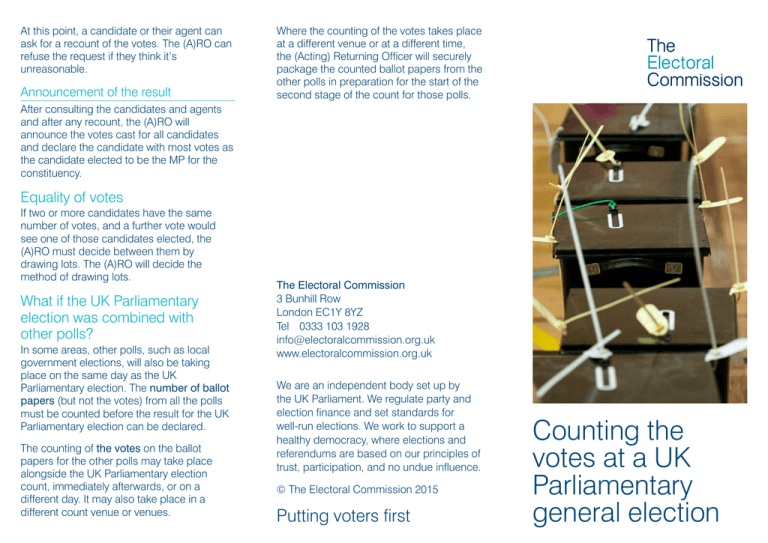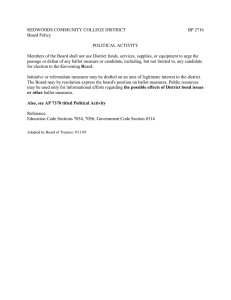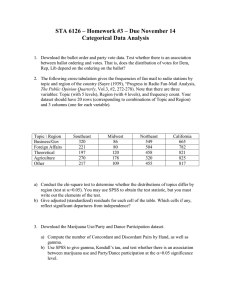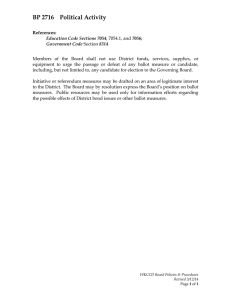Counting the votes at a UK Parliamentary general election
advertisement

At this point, a candidate or their agent can ask for a recount of the votes. The (A)RO can refuse the request if they think it’s unreasonable. Announcement of the result Where the counting of the votes takes place at a different venue or at a different time, the (Acting) Returning Officer will securely package the counted ballot papers from the other polls in preparation for the start of the second stage of the count for those polls. After consulting the candidates and agents and after any recount, the (A)RO will announce the votes cast for all candidates and declare the candidate with most votes as the candidate elected to be the MP for the constituency. Equality of votes If two or more candidates have the same number of votes, and a further vote would see one of those candidates elected, the (A)RO must decide between them by drawing lots. The (A)RO will decide the method of drawing lots. What if the UK Parliamentary election was combined with other polls? In some areas, other polls, such as local government elections, will also be taking place on the same day as the UK Parliamentary election. The number of ballot papers (but not the votes) from all the polls must be counted before the result for the UK Parliamentary election can be declared. The counting of the votes on the ballot papers for the other polls may take place alongside the UK Parliamentary election count, immediately afterwards, or on a different day. It may also take place in a different count venue or venues. The Electoral Commission 3 Bunhill Row London EC1Y 8YZ Tel 0333 103 1928 info@electoralcommission.org.uk www.electoralcommission.org.uk We are an independent body set up by the UK Parliament. We regulate party and election finance and set standards for well-run elections. We work to support a healthy democracy, where elections and referendums are based on our principles of trust, participation, and no undue influence. © The Electoral Commission 2015 Putting voters first Counting the votes at a UK Parliamentary general election Who’s who at the count What happens at a count? Many people are involved in running an election count, but you are most likely to come across the following: Arrival of ballot boxes •The (Acting) Returning Officer [(A)RO] – this is the person in charge of the election •Deputy (A)ROs – they will be assisting the (A)RO throughout the count •Supervisors – they will be supervising the count teams and reporting to the (A)RO and his/her deputies •Counters – they will be divided into count teams and will count the ballot papers and the votes Timing of the count At a UK Parliamentary election, the (A)RO must take reasonable steps to begin counting the votes within four hours of the close of poll at 10pm (i.e. by 2am on Friday 8 May 2015). There are two stages to any election count: first, count staff will be counting the number of ballot papers at the count, then, they will be counting the votes on the ballot papers. It is this second stage which should start by 2am. A number of factors might impact on when the votes can begin to be counted, for example the geography of the constituency and how long it takes to get the ballot boxes in from the polling stations and the number of other polls taking place in that area on the same day. Staff will deliver the ballot boxes containing postal votes and the ballot boxes from the polling stations to the count venue. Each ballot box will have been allocated a specific number and will be checked in on arrival. First stage of the count: counting the number of ballot papers This stage is crucial as it checks that all ballot papers are properly accounted for and that the number of ballot papers delivered to the count matches the number expected. At this stage count staff will be comparing the actual numbers of ballot papers in each ballot box against the ballot paper account. This is a form completed by the Presiding Officer at each polling station accounting for the ballot papers they have issued. Postal votes are accounted for in a similar way. Ballot boxes are opened and emptied onto tables. The empty boxes are shown to everyone present. Count teams count and record the number of ballot papers in each ballot box. Where the number of ballot papers matches the number expected, the ballot papers are ready to go to the second stage of the count. Where they don’t, the count team will be asked to recount the ballot papers until the numbers match or until the same number of ballot papers is arrived at twice in a row. Any discrepancies between the numbers on the ballot paper account and those in the ballot box are recorded. The (A)RO will prepare a statement showing how many ballot papers were received in each ballot box against how many ballot papers were expected. This statement will be provided to candidates and agents. Second stage of the count: counting the votes on the ballot papers Ballot papers from different ballot boxes are mixed to preserve the secrecy of the vote. Ballot papers are then allocated to count teams which will sort ballot papers by candidate. Ballot papers that are not marked with an ‘X’ in the box next to a candidate are given to the (A)RO, or a deputy, to adjudicate – these are called ‘doubtful’ ballot papers. As long as the intention of the voter is clearly apparent, the vote can be accepted as valid and be counted. If it is not possible for the (A)RO to work out the voter’s intention the ballot paper is rejected and marked with the reason for the rejection. These are called ‘rejected’ votes. After the sorting is complete, count teams will count the number of votes cast for each candidate. Once all of the valid votes and any rejected votes have been added together and checked against the total number of ballot papers from the first stage of the count, the (A)RO will share the provisional result with candidates and their agents.



